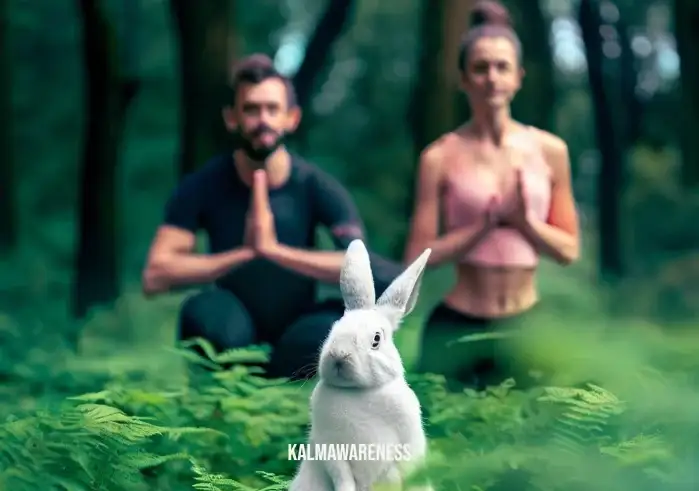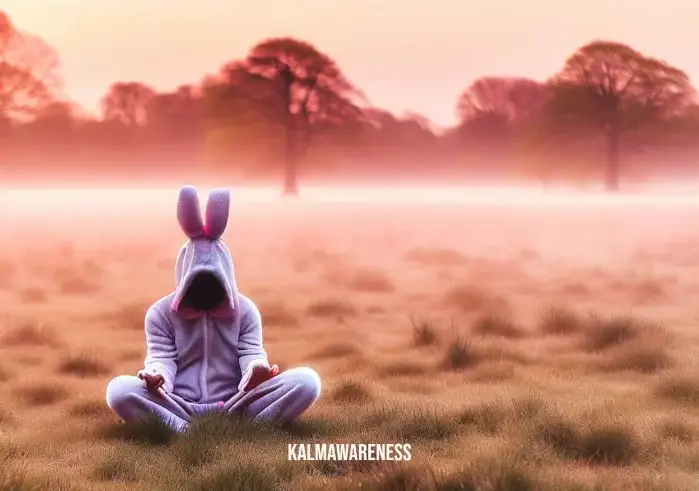The Joyful Rabbit
In this article, we will explore the enchanting world of yoga and delve into a captivating pose known as the “Joyful Rabbit.” This pose, also referred to as the “Rabbit Yoga Pose,” combines grace and tranquility, making it a delightful addition to your yoga practice.
Table of Contents
- Description and Explanation
- Pose Name and Original Name
- Difficulty Level and Pose Category
- Exercise Duration
Description and Explanation
The Joyful Rabbit, or Rabbit Yoga Pose, is an asana that exudes a sense of playfulness and vitality. This pose is named after the delightful way a rabbit moves, stretching and curling its body. By emulating the movements of this adorable creature, the Joyful Rabbit brings a sense of joy and lightheartedness to your yoga practice.
In this pose, you will start in a kneeling position, sitting back on your heels. As you bend forward, your forehead will rest on the mat or ground in front of you, symbolizing the rabbit’s burrow. Your arms will extend backward, reaching for your heels, as if the rabbit is stretching its paws.
Benefits of the Joyful Rabbit Pose:
- Stretches the spine and shoulders, promoting flexibility.
- Calms the mind and relieves stress and anxiety.
- Stimulates the digestive organs, aiding in digestion.
- Opens the heart and chest, encouraging a sense of openness.
“The Joyful Rabbit pose brings a sense of playful serenity to your practice, reminding us to embrace joy in the simplest of movements.”
Pose Name and Original Name
Pose Name: Joyful Rabbit Original Name: Sasangasana
Difficulty Level and Pose Category
Difficulty Level: Beginner to Intermediate Pose Category: Forward Bend/Heart Opener
Exercise Duration
For beginners, it is recommended to hold the Joyful Rabbit pose for about 20 to 30 seconds, gradually increasing the duration with practice. For advanced practitioners, holding the pose for 40 to 60 seconds can provide deeper benefits.
Step-by-Step Guide for the Joyful Rabbit Pose:
- Start by kneeling on the mat with your buttocks resting on your heels. Your toes should be touching and your hands resting on your thighs.
- As you inhale deeply, lean forward, placing your forehead on the mat in front of your knees. Keep your arms alongside your body, palms facing up.
- Slowly reach your arms backward, taking hold of your heels with your hands. If you find it challenging to reach your heels, you can use yoga blocks for support.
- As you exhale, gently lift your hips toward the ceiling, creating a gentle stretch along your spine.
- Relax your neck and let your head hang naturally, feeling the stretch along your back and shoulders.
- Breathe deeply and hold the pose for the recommended duration, feeling a sense of release and joy with each breath.
- To release the pose, gently let go of your heels and bring your hands back to your thighs. Slowly sit up and return to a comfortable kneeling position.
As you practice the Joyful Rabbit Pose, embrace the playful spirit of this graceful creature and allow its essence to infuse your yoga journey with joy and serenity.

The Joyful Rabbit
Welcome to the second part of our journey through the enchanting world of the Joyful Rabbit Pose, also known as the Rabbit Yoga Pose. In this chapter, we will explore the myriad benefits of this delightful asana, as well as guidelines on who can practice it and variations suitable for different experience levels.
Benefits of the Joyful Rabbit Pose
The Joyful Rabbit Pose offers a wide array of physical, mental, and emotional benefits that contribute to a well-rounded yoga practice. Let’s dive into some of the advantages this pose brings:
- Spinal Flexibility: The deep forward bend in the Joyful Rabbit Pose stretches the entire length of the spine, improving its flexibility and mobility.
- Shoulder and Neck Release: As you reach back and grasp your heels, your shoulders and neck receive a gentle stretch, alleviating tension and stiffness.
- Stress Relief: The calming nature of the pose helps soothe the mind and reduce stress and anxiety, promoting a sense of tranquility.
- Digestive Health: The compression of the abdomen in this asana stimulates the digestive organs, aiding in digestion and promoting better gut health.
- Heart Opening: The backbend aspect of the pose opens the heart and chest, inviting feelings of compassion and self-love.
- Energizing Effect: Despite its gentle appearance, the Joyful Rabbit Pose can offer an invigorating boost of energy when held for a longer duration.
- Improved Posture: Regular practice of this pose helps improve posture by strengthening the back muscles and aligning the spine.
- Flexibility Enhancement: As you reach for your heels, your leg muscles, hip flexors, and quadriceps get stretched, gradually increasing flexibility.
- Calms the Nervous System: The forward bend has a soothing effect on the nervous system, promoting relaxation and a sense of balance.
- Stimulates Circulation: The elongation of the spine encourages improved blood flow throughout the body, enhancing circulation.
Who Cannot Do the Joyful Rabbit Pose
While the Joyful Rabbit Pose offers numerous benefits, there are certain situations where it may not be suitable. Avoid practicing this pose if you:
- Knee or Ankle Injuries: If you have knee or ankle injuries, it’s best to avoid this pose, as it places pressure on these joints.
- High Blood Pressure: As the pose involves a forward bend, it may increase blood pressure in individuals with hypertension. Consult a healthcare professional before attempting.
- Vertigo or Dizziness: If you experience vertigo or dizziness, the forward bend may exacerbate these symptoms. Modify or avoid the pose if needed.
- Pregnancy: Pregnant individuals should practice the Joyful Rabbit Pose with caution and seek guidance from a qualified prenatal yoga instructor.
Variations of the Joyful Rabbit Pose
The Joyful Rabbit Pose can be adapted to suit practitioners of different experience levels. Here are some variations to explore:
- Supported Rabbit Pose: For beginners or those with limited flexibility, place a bolster or folded blanket on your heels before reaching back with your arms. This provides extra support and makes the pose more accessible.
- Bound Rabbit Pose: For intermediate practitioners, interlace your fingers behind your back while reaching for your heels. This deepens the shoulder stretch and opens the chest further.
- One-Legged Rabbit Pose: Advanced yogis can challenge themselves by extending one leg straight back while holding the opposite heel. This variation requires balance and flexibility.
- Rolling Rabbit Pose: As you hold the pose, gently roll forward and backward on your forehead, massaging the third eye area and adding a gentle massage to the spine.

The Joyful Rabbit
Welcome to the final part of our exploration of the enchanting Joyful Rabbit Pose, also known as the Rabbit Yoga Pose. In this chapter, we will delve into the fascinating history of this pose, its spiritual significance, tips for maximizing its benefits, common mistakes to avoid, modifications for those with injuries or limited flexibility, and poses that beautifully complement the Joyful Rabbit Pose.
The History of the Joyful Rabbit Pose
The origins of the Joyful Rabbit Pose trace back to ancient yogic traditions, where animal-inspired poses were practiced to embody the qualities of the animals they represented. Rabbits symbolize playfulness, agility, and a strong connection to nature. Yogis drew inspiration from the grace and joy exuded by these creatures and crafted the Joyful Rabbit Pose to mirror their movements.
The Spiritual Significance of the Joyful Rabbit Pose
Beyond its physical benefits, the Joyful Rabbit Pose holds profound spiritual symbolism. As you assume the pose, you connect with the earth, drawing on the rabbit’s burrowing nature to find a sense of grounding and safety. The forward bend symbolizes going inward, turning your focus inward to explore your emotions and thoughts. In this introspective state, you can embrace joy and lightness, mirroring the carefree nature of rabbits. The pose encourages you to release worries and fears, finding contentment in the present moment.
Tips for Getting the Most out of the Joyful Rabbit Pose
To fully experience the magic of the Joyful Rabbit Pose, consider these tips:
- Breathe Mindfully: Focus on your breath throughout the pose, allowing it to guide your movements and create a sense of calm.
- Maintain Alignment: Keep your knees hip-width apart and ensure your spine remains long and extended as you bend forward.
- Shoulder Relaxation: Relax your shoulders away from your ears as you stretch your arms backward, avoiding unnecessary tension.
- Be Gentle: The Joyful Rabbit Pose is gentle and nurturing. Approach the pose with kindness and avoid forcing yourself into the stretch.
Common Mistakes to Avoid
Avoid these common mistakes to enhance your Joyful Rabbit Pose experience:
- Straining the Neck: Instead of tucking your chin tightly to your chest, let your neck and head hang naturally.
- Overextending the Back: Remember that the pose is a gentle stretch; avoid overarching your back to prevent injury.
- Neglecting Breathing: Stay aware of your breath; do not hold it or breathe shallowly during the pose.
Modifications for People with Injuries or Limited Flexibility
For those with injuries or limited flexibility, modifications can make the Joyful Rabbit Pose more accessible:
- Use Props: Place a cushion or folded blanket under your knees to reduce pressure on them.
- Raise the Hips: If reaching for your heels is challenging, place yoga blocks behind your heels and rest your hands on them.
- Seated Variation: For individuals unable to kneel, sit on a chair or a yoga block with feet flat on the floor and perform a forward bend.
Poses Complementary to the Joyful Rabbit Pose
To create a well-rounded yoga practice, consider incorporating these complementary poses:
- Child’s Pose (Balasana): This gentle resting pose complements the Joyful Rabbit Pose by providing a soothing stretch for the back and hips.
- Camel Pose (Ustrasana): As a heart opener, the Camel Pose beautifully complements the Joyful Rabbit Pose’s chest-opening aspect.
- Seated Forward Bend (Paschimottanasana): This seated stretch complements the forward bend of the Joyful Rabbit Pose, encouraging deeper flexibility.





